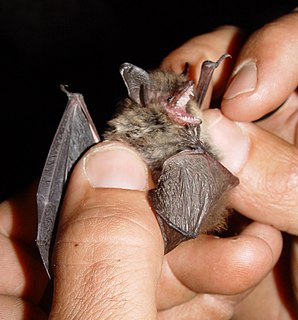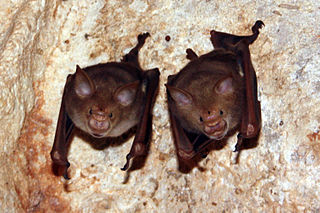
Vespertilionidae is a family of microbats, of the order Chiroptera, flying, insect-eating mammals variously described as the common, vesper, or simple nosed bats. The vespertilionid family is the most diverse and widely distributed of bat families, specialised in many forms to occupy a range of habitats and ecological circumstances, and it is frequently observed or the subject of research. The facial features of the species are often simple, as they mainly rely on vocally emitted echolocation. The tails of the species are enclosed by the lower flight membranes between the legs. Over 300 species are distributed all over the world, on every continent except Antarctica. It owes its name to the genus Vespertilio, which takes its name from a word for bat, vespertilio, derived from the Latin term vesper meaning 'evening'; they are termed as evening bats and once referred to as 'evening birds'.

The mouse-eared bats are a diverse and widespread genus (Myotis) of bats within the family Vespertilionidae.

Megadermatidae, or false vampire bats, are a family of bats found from central Africa, eastwards through southern Asia, and into Australia. They are relatively large bats, ranging from 6.5 cm to 14 cm in head-body length. They have large eyes, very large ears and a prominent nose-leaf. They have a wide membrane between the hind legs, or uropatagium, but no tail. Many species are a drab brown in color, but some are white, bluish-grey or even olive-green, helping to camouflage them against their preferred roosting environments. They are primarily insectivorous, but will also eat a wide range of small vertebrates.

The silver-tipped myotis is a species of mouse-eared bat found in a range of lowland habitats in the Americas.

The velvety myotis, is a species of vesper bat from South America.

Myotis fimbriatus is a species of vesper bat in the family Vespertilionidae. It is found only in China. It's also called the fringed long-footed myotis. The fringed long-footed myotis is described as having short, thick, brown fur with pale whitish fur ventrally. A captured female was measured with ears that were 14.4 mm long, a forearm 42.2 mm long, and a weight of 9.9 grams. Myotis fimbriatus is listed as being of least concern by the IUCN as of 2008. In 2000, Myotis fimbriatus was listed as being "lower risk/near threatened".

Myotis vivesi, the fish-eating bat or fish-eating myotis, is a species of bat that lives around the Gulf of California, and feeds on fish and crustaceans. It is the largest species of the genus Myotis in the Americas, and has exceptionally large feet, which it uses in hunting. It was described in 1901 by Auguste Ménégaux and is the only species in the subgenus Pizonyx.

The Jamaican fig-eating bat is a species of bat in the family Phyllostomidae. It is the only living species in the genus Ariteus. The scientific name translates as "yellowish and warlike". There are no recognised subspecies.
Myotinae is a subfamily of vesper bats. Submyotodon is the second extant genus included in the subfamily Myotinae. Before the description of Submyotodon and analysis of its phylogenetics, the only member of Myotinae was the genus Myotis.

Miniopterus, known as the bent-winged or long winged bats, is the sole genus of the family Miniopteridae. They are small flying insectivorous mammals, micro-bats of the order Chiroptera, with wings over twice the length of the body. The genus had been placed in its own subfamily among the vespertilionid bats, as Miniopterinae, but is now classified as its own family.

The Hipposideridae are a family of bats commonly known as the Old World leaf-nosed bats. While it has often been seen as a subfamily, Hipposiderinae, of the family Rhinolophidae, it is now more generally classified as its own family. Nevertheless, it is most closely related to Rhinolophidae within the suborder Yinpterochiroptera.
Miniopterus zapfei is a fossil bat in the genus Miniopterus from the middle Miocene of France. First described in 2002, it is known only from the site of La Grive M, where it occurs with another fossil Miniopterus species, the smaller and more common Miniopterus fossilis. M. zapfei is known from five mandibles and an isolated fourth upper premolar (P4). The fourth lower premolar is more slender than in M. fossilis and the cingulum shelf surrounding the P4 is less well-developed than in living Miniopterus. The length of the first lower molar is 1.57 to 1.60 mm.
Miniopterus tao is a fossil bat in the genus Miniopterus from the Pleistocene of Zhoukoudian in China. It is known from a number of mandibles, which were initially identified as the living species Miniopterus schreibersii in 1963 before being recognized as a separate species, M. tao, in 1986. Miniopterus tao is larger than living M. schreibersii and has more closely spaced lower premolars and more robust talonids on the lower molars. The back part of the mandible is relatively low and on it, the coronoid and condyloid processes are about equally high. The average length of the mandible is 12.0 mm.

The Bocharic myotis or Bokhara whiskered bat is a species of mouse-eared bat in the family Vespertilionidae, described in 1950, and indigenous to Tajikistan, and Uzbekistan.
The Taiwan broad-muzzled myotis is a species of vesper bat found in Taiwan.

Aeorestes is a genus or subgenus of vesper bat commonly known as the hoary bats. As a genus, it includes species that were formerly included in the genus Lasiurus.
Rhinonycteridae is a family of bats, allied to the suborder Microchiroptera. The type species, the orange nose-leafed species group Rhinonicteris aurantia, is found across the north of Australia.
The Moupin broad-muzzled mouse-eared bat(Submyotodon moupinensis) is a bat in the family Vespertilionidae endemic to southern China.











